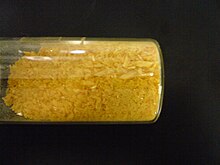This is an old revision of this page, as edited by Rifleman 82 (talk | contribs) at 03:45, 14 June 2011 (both cis and trans known). The present address (URL) is a permanent link to this revision, which may differ significantly from the current revision.
Revision as of 03:45, 14 June 2011 by Rifleman 82 (talk | contribs) (both cis and trans known)(diff) ← Previous revision | Latest revision (diff) | Newer revision → (diff) | |
 | |
| Identifiers | |
|---|---|
| CAS Number | |
| 3D model (JSmol) | |
| ChemSpider | |
| ECHA InfoCard | 100.034.299 |
| PubChem CID | |
| CompTox Dashboard (EPA) | |
InChI
| |
SMILES
| |
| Properties | |
| Chemical formula | C36H30Cl2P2Pd |
| Molar mass | 701.90 g·mol |
| Except where otherwise noted, data are given for materials in their standard state (at 25 °C , 100 kPa).
| |
Bis(triphenylphosphine)palladium(II) dichloride is a coordination compound of palladium containing two triphenylphosphine and two chloride ligands. This yellow complex is often used for palladium-catalyzed coupling reactions, e.g. the Sonogashira–Hagihara reaction. The complex is square planar. Both cis and trans isomers are known.
Commercially available, this compound may be prepared by reacting palladium(II) chloride with triphenylphosphine:
- PdCl2 + 2 PPh3 → PdCl2(PPh3)2
The complex is an intermediate in the preparation of tetrakis(triphenylphosphine)palladium (Pd(PPh3)4):
- PdCl2(PPh3)2 + 2 PPh3 + 2.5 N2H4 → Pd(PPh3)4 + 0.5 N2 + 2 N2H5Cl
References
- Norio Miyaura and Akira Suzuki (1993). "Palladium-catalyzed reaction of 1-alkenylboronates with vinylic halides: (1Z,3E)-1-Phenyl-1,3-octadiene". Organic Syntheses; Collected Volumes, vol. 8, p. 532.
- D. R. Coulson; Satek, L. C.; Grim, S. O. (1972). "23. Tetrakis(triphenylphosphine)palladium(0)". Inorg. Synth. 13: 121. doi:10.1002/9780470132449.ch23.
| Palladium compounds | |||
|---|---|---|---|
| Pd(0) |
| ||
| Pd(II) |
| ||
| Pd(II,IV) | |||
| Pd(IV) | |||
| Pd(VI) | |||